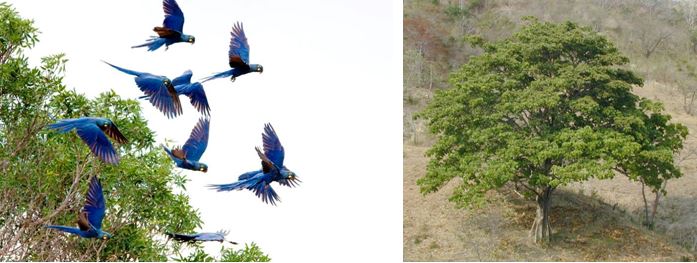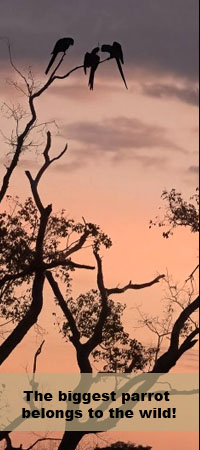Creating and supporting marine protected areas. Marine protected areas working but at risks
The Hyacinth macaw (Anodorhynchus hyacinthinus) is the largest psitacid (parrot) in the world, currently considered endangered because the remaining small populations are undergoing very rapid reductions as a result of illegal trapping and habitat loss.
The hyacinth macaw occurs today in three main regions in South America: In the Pantanal region of Brazil (important site for macaw), and adjacent eastern Bolivia and northeastern Paraguay, in the cerrado regions of the eastern interior of Brazil.

The macaw prefers semi-open, somewhat wooded habitats. It usually avoids dense, humid forest, and in regions dominated by such habitats, it is generally restricted to the edge or relatively open sections.In the Pantanal wetlands of Central Brazil, the endangered hyacinth macaw makes its nest almost exclusively in natural hollows found in the manduvi tree (see photo above).The recruitment and survival of manduvi trees greatly depends on the seed dispersal provided by the toco toucan (Ramphastos toco), responsible for around 80% of the seed dispersal.The toco toucan, however, is responsible for about 50% of the preyed eggs, resulting in a case of conflicting ecological pressures in which the reproduction of the hyacinth macaw is indirectly dependent on the seed dispersal services of its nest predator.
The population size is estimated of about 4,300 individuals in the wild. Most of the hyacinth macaw diet is composed of nuts from specific palm species, such as acuri and bocaiuva palms.Their strong beaks can crack coconuts, the large Brazil nut pods, and macadamia nuts.Further, they forage on fruits and other vegetable matter and can travel for the ripest of foods over a vast area.
Habitat loss and illegal capture
Throughout the macaw's range, habitat is being lost or altered due to the introduction of cattle ranching and mechanized agriculture. This year, large fires devastated critical refuge for hyacinth macaws in Brazil. This year’s fires struck at the beginning of the macaw’s breeding burning trees with nests weakening one of the healthiest macaw populations found in the wild.
The largest parrot is also victim of its beauty and kept as a pet. Traffickers fly the eggs to Europe and US, incubate them and pass off the live birds as captive-bred to become legal.
What to do next for the hyacinth macaw?
The creation of protected areas is an important conservation strategy for the hyacinth macaw in the face of native vegetation conversion and loss. Further, patrols against illegal capture of macaws and its eggs are crucial in areas where nesting occurs. The Pantanal biome, where the hyacinth macaw occurs, is one of the largest inland wetlands in the world. Currently, only 11% of the Pantanal is protected, 7% with full protection and 4% under sustainable use. Clearly it is not enough, that is why Endangered Species International is pursuing the creation of effective protected area in the Pantanal region.
JOIN US to stop illegal traffickers to collect eggs from the wild and help us to create land protected areas for the hyacinth macaw.
Related Links
|






